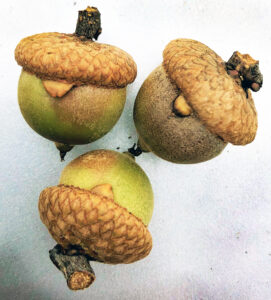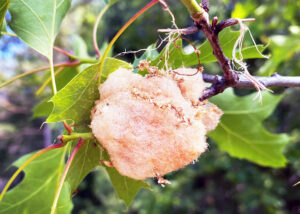By Linda Williams, DNR Forest Health Specialist, Woodruff; Linda.Williams@wisconsin.gov or 920-360-0665

Pip galls are small, tongue-like protrusions emerging from under the caps of acorns. / Photo Credit: Linda Williams, Wisconsin DNR.
Gall wasp life cycles can be complex. Did you know that acorn pip galls, which I’ve written about several times, have another part of their life cycle that is entirely different? This stage is called the woolly catkin gall.
Both woolly catkin galls and acorn pip galls are caused by Callirhytis quercusoperator, a species of cynipid gall wasp. This gall wasp takes two years to complete development by going through the two parts of its life cycle. Both parts of the life cycle are completed on northern red oak in our area.
The acorn pip galls are in the asexual life cycle stage; the gall wasps that emerge from the acorn pip galls are all female and do not need to mate. They will appear in the spring and lay eggs on the male flowers of red oak. The trees then produce the fuzzy mass called a woolly catkin gall that envelops the developing larvae. When those larvae complete development and emerge, males and females will mate, and the resulting eggs will be laid on newly developing acorns. The pip galls will develop for over a year, emerging in the spring as female gall wasps to infest the male catkins.

A woolly catkin gall forms on male flowers, which can be seen mixed in with a hairy gall. / Photo Credit: Linda Williams, Wisconsin DNR.
Wool sower galls look very similar to woolly catkin galls but are found on white oaks, whereas woolly catkin galls are found on red oaks. Both are gall wasps in the Callirhytis genus, which are generally referred to as cynipid galls. Other oak galls caused by cynipid gall wasps in the genus Callirhytis include horned oak gall, leaf vein gall and gouty oak galls.
The gall wasps that produce woolly catkin galls and acorn pip galls are tiny, 2-3mm in size, and they don’t sting, so most people will never notice the actual insects in their lifetime.
This spring was a good year to spot the woolly catkin galls, which can be abundant. Woolly catkin galls don’t harm the tree in any way, so no control is necessary. The acorn pip galls cause the acorns to become nonviable, but there are no known management options to limit gall production in forests.
